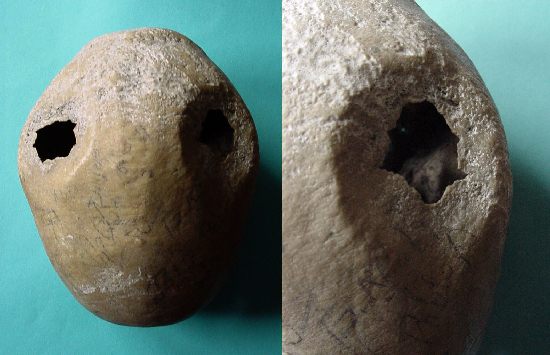Surgery |
||
Trepanned cranium, Peru |
||
The trepanation - the opening of the bony skull - was the first major surgical procedure people performed. Since the days of the country doctor Pierre Barthélémy PRUNIERES (1828-1893), who discovered skulls in prehistoric skulls in the Lozère valley in southern France in 1873, one knows that skulls were traversed in ancient times. His compatriot Paul BROCA (1824-1880) recognized that these had been done on living and surviving patients. In 1874, at an anthropological congress in Lille, Pruneier showed him one of his skulls, and Broca immediately recognized the callus at the margin of the trephine opening, a testimony to the survival of the operated person.
The survival rate of the trephines varied in the Neolithic period depending on the surgeon:
Three problems had to be solved for the surgeon:
Magic rites or rational treatment of skull injuries? After initially thinking of magical backgrounds, especially in prehistoric trephines, recent studies on craniofacial surgery in Peru show residual states after trauma in the majority of skulls. Apparently, the trepanation corresponds to a special kind of warfare of that time, when you slashed your opponent with a sling and stone-honed club ...
exhibit The presented skull comes from the disbanded collection of a US diplomat who acquired the skull in 1950 by an anthropologist in Lima. Presumably the peninsula PARACAS, where the researcher Julio C. TELLO (1880-1947) from 1925 excavated hundreds of these skulls. The so-called Paracas civilization existed from 800 BC. until about 200 AD. One reason for their disappearance, the archaeologists could not make out to this day. Similar skulls were recently found among the people of Chachapoya, the "cloud people", who lived in the period 800-1475 AD. lived in the high mountains of northern Peru. From the Paracas they had apparently learned the technique of trepanation in scraping technique.
The earliest skull opening technique is probably the so-called "area cockroach". In Peru, it was scraped but also sawn, chiselled and drilled. The scraper technique was applied to the skull presented here with its typical double reworking. After the recordings, we wiped away the cracks on the surface of the skull - they testified to the particularly brash manner of some of our contemporaries to deal with the remains of their ancestors. But we did not want to issue these "autographs" in our small museum, but the skull with its finely healed wound edges.
Lit .:
If you want to treat yourself to the "kick" of a trepanierten skull on holiday, go to Normandy to Avranches. Here, in the basilica "Saint-Gervais-et-Saint-Protais", the skull of Sts. Aubert was exhibited as "Le crâne avec l'emprinte du doigt de l'archange Michel" - in reality a Stone Age skull with traces of a trepanation. Recent investigations have also raised the hypothesis of a skull cyst in a medieval skull ...
Our ancestors, the Celts, first practiced the scraping technique. Like a noble luxury item, they eventually imported a new trepanation method from the Mediterranean to the north: drilling with a hollow drill, which cut a round bone plate from the skull. Not infrequently, these skull slices were worn in ancient times as an amulet around the neck |




